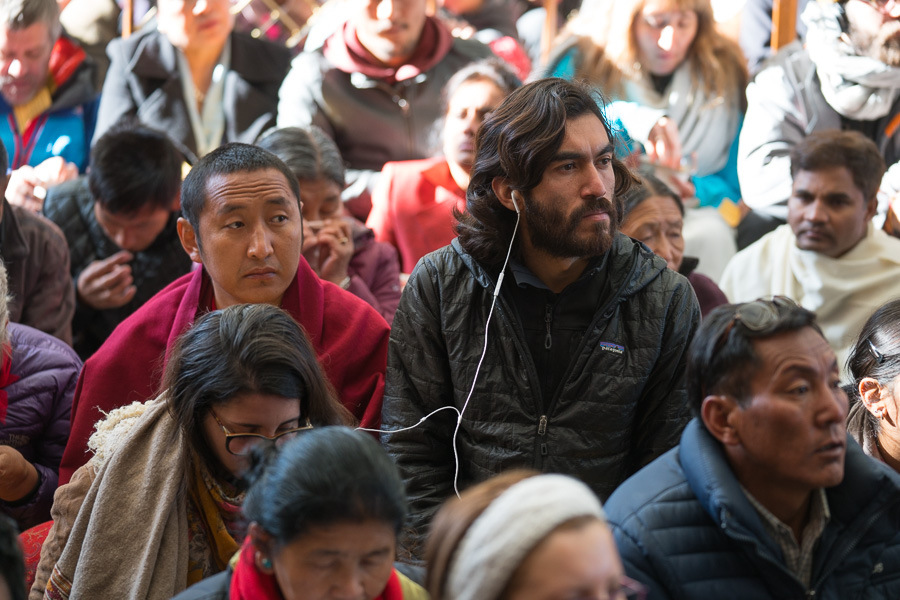Thekchen Chöling, Dharamsala, HP, India, 12 March 2017 – The sky was a pristine blue as the peaks of the Dhauladhar range glinted in the rising sun this morning as people gathered in the yard of the Tsuglagkhang adjacent to His Holiness the Dalai Lama’s residence. After several days of rain and snow on the mountains it was bitterly cold. His Holiness had earlier gone to the temple to participate in the bimonthly ‘Confession and Restoration’ ceremony. Meanwhile monks of Gyumey Tantric College engaged in debate before the throne in the yard.
When His Holiness descended the temple steps shortly after 8 o’clock he was escorted in front by monks of Namgyal Monastery wearing their yellow crested hats and playing horns and behind by a monk holding a ceremonial umbrella. He greeted members of the audience before taking his seat on the throne. The Chant Master led recitations of the Heart Sutra, a lineage prayer, the offering of a mandala to request the teaching and the verse for taking refuge and generating the awakening mind.
His Holiness set the scene for the day’s teaching by explaining that 2600 years ago in India there were many other religious and philosophical traditions. They were all beneficial to their followers in their way, and many continue to be so. Where the Buddha differed from them was in his explanation of the profound view of selflessness—things’ lack of independent existence. He explained that the cause of suffering was that we are all under the sway of disturbing emotions because we tend to cling to the idea that things have an independent existence.
His Holiness remarked that this is illustrated in paintings of the Wheel of Life. In the outer rim are depictions of the twelve links of dependent arising, which begin with ignorance. Consequently, we are born in the six realms of existence—white or wholesome karma results in birth in the upper reams, whereas black or unwholesome karma takes us to the lower realms, as the picture shows. Our actions tend to be driven by the three poisons or disturbing emotions of desire, hatred and ignorance, portrayed by rooster, snake and pig respectively at the hub of the wheel.
“We suffer because we create karma,” he said, “and we do that under the influence of disturbing emotions. They, in turn, are rooted in the ignorance of misconceiving things as independently existent. Look at the tree over there; it seems to be independently existent. But if we look for it among its parts, its trunk, its branches or its leaves, we can’t find the tree. And yet those parts are parts of the tree. Today, even scientists say things don’t have any objective existence. The Buddha taught about reality—how things are.
“However, the Buddha’s explanation of selflessness was not convincing for the teachers of many other traditions. Together they engaged in a contest of miracles. Today commemorates the occasion in Shravasti when the Buddha defeated his opponents in that contest. In the Tibetan tradition, celebrations of this event were introduced by Je Tsongkhapa as part of the Great Prayer Festival. This is counted as one of the four great deeds of his life.
“In Tibet, we had the first spread of Buddhist teachings, which fell into decline. The second spread began with Rinchen Zangpo. Atisha was invited to Tibet at this time and he wrote the ‘Lamp for the Path’ there. He established the Kadampa tradition, which consisted of three lineages. Of these, the Scriptural Lineage focussed on six texts—the Jataka Tales and the Tibetan equivalent of the Dhammapada, the Udanavarga. Also included were Shantideva’s ‘Guide to the Bodhisattva’s Way of Life’ and ‘Compendium of Training’, Asanga’s ‘Bodhisattva Grounds’ and Maitreya’s ‘Ornament of Sutras’. The Jataka tales recount exemplary deeds of the Buddha in his previous lives as a Bodhisattva.”
Today, His Holiness read the final story in the collection of thirty-four tales. It concerned a time when the Bodhisattva had been born as a woodpecker. One day as he flew he spied an old lion dusty and in distress and felt moved to ask what troubled him. The lion told him he had piece of bone stuck in his throat that he could not dislodge. It was giving him great discomfort and he pleaded with the bird to help him if he could. The woodpecker thought carefully and asked the lion to open his mouth. He placed a stick between his jaws to prevent them closing and flew into the open mouth. Tugging at the bone he managed to remove it and as he flew out kicked the stick out of the way too. In this way, the Bodhisattva in the form of a woodpecker relieved the lion of great pain.
Sometime later, conditions were such that the woodpecker had been unable to find enough to eat and was wracked with hunger. He came across the same lion eating a fresh kill and paced up and down hoping to be offered a share. When that was ineffective he asked the lion to let him eat too. The lion roared and refused, teaching the bird that there are beings who will accept help only to give nothing in return.
Having reached the end of the text, His Holiness followed tradition and, turning back to the beginning, read a little from the first tale in the collection. He mentioned that the author, Aryashura, had been a skilful nonBuddhist debater who challenged the monks of Nalanda. Concerned that he might defeat them they called on Nagarjuna to help. He deputed his disciple Aryadeva in his stead. Aryashura was duly defeated and became Aryadeva’s disciple.
Next, His Holiness announced that in addition to his various hymns to the Buddha, he had come across a short text by Nagarjuna called ‘Praise to the Vajra Mind’. A printed copy had been distributed to the crowd and he read it to them. By way of context, he mentioned that some religious practice involves physical activity such as ablutions. Some, like the Vedas, focusses on the efficacy of sound. Buddha Shakyamuni, however, taught how to practise with the mind.
“In this short text, Nagarjuna pays homage to the mind itself, for it is the mind that can eliminate the net of conceptions, the ignorance that leads to the disturbing emotions, to creating karma and to suffering. Samsara is rooted in the mind. There is no pain or pleasure apart from the mind. Practice on the basis of the altruistic intention is beneficial. Objects of the mind have conventional existence. They exist on the basis of designation.
“Samsara is in conceptions; nirvana is the absence of conceptions. Do away with conceptions and the disturbing emotions and you achieve nirvana. The subtlest clear light mind has no beginning or end. From this excellent mind arises Buddhahood.”
His Holiness completed his reading of ‘Praise to the Vajra Mind’ by citing the well-know verse:
Commit not a single unwholesome deed,
Cultivate a wealth of virtue,
To completely tame this mind of ours—
This is the teaching of the Buddhas.

View of the courtyard of the Main Tibetan Temple where thousands gathered to listen to His Holiness the Dalai Lama’s Jataka Tale teaching in Dharamsala, HP, India, on March 12, 2017. Photo by Tenzin Choejor/OHHDL

Some of the audience listening to His Holiness the Dalai Lama’s explanation of one of the Jataka Tales at the Main Tibetan Temple in Dharamsala, HP, India, on March 12, 2017. Photo by Tenzin Choejor/OHHDL

